Tennessee Folklore Society
Annual Meetings -- Another Online Sampler
Presented
November 6, 2021
(See the previous online sampler here)
The Tennessee Folklore Society was founded in
1934 to encourage research and documentation about Tennessee
folk culture. Since then it has continuously published the Tennessee
Folklore Society Bulletin and, except during World
War II, held annual meetings with lectures and screenings about
a wide range of Tennessee folklife topics, from traditional
music to folktales and verbal arts, practices and customs, and
material culture. Over the years, TFS meetings have provided an
important forum for members and guests and helped sustain a
statewide advocacy network for the field. This year, the
Covid-19 pandemic (like gas rationing during WWII) now
unfortunately prohibits the society from holding its
face-to-face annual meeting for 2020.
In its stead, the TFS is posting an online sample
of outstanding sessions from annual meetings in recent years,
made possible by the recording and editing of longtime TFS
member and videographer Martin Fisher. The videos demonstrate
the diverse interests embraced by the society members and its
mission, and we hope they will help increase awareness of the
TFS and invite new audiences to join in its future activities:
For a playlist of the below presentations click here
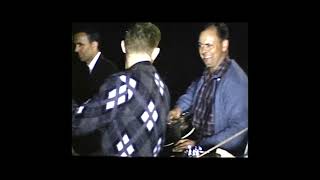 “Jamboree Time:
Remembering Radio in East Tennessee” (Bradley
Hanson, 2015, 30:46 minutes). This documentary video
is the result of Hanson’s lengthy research , initiated in
fieldwork for the Tennessee State Parks Folklife Project and
culminating in his doctoral dissertation, on one
community’s musical and broadcasting history. The
Tennessee Jamboree was a weekly musical “barndance” event in
LaFollette, Tennessee, broadcast on local radio station WLAF
from 1953 to 1978. Drawing on Hanson’s interviews and rare
surviving film clips, the video details the story of this
small-town cultural scene, the musicians and businesses
who helped it succeed, and its contributions to the life of the
community.
“Jamboree Time:
Remembering Radio in East Tennessee” (Bradley
Hanson, 2015, 30:46 minutes). This documentary video
is the result of Hanson’s lengthy research , initiated in
fieldwork for the Tennessee State Parks Folklife Project and
culminating in his doctoral dissertation, on one
community’s musical and broadcasting history. The
Tennessee Jamboree was a weekly musical “barndance” event in
LaFollette, Tennessee, broadcast on local radio station WLAF
from 1953 to 1978. Drawing on Hanson’s interviews and rare
surviving film clips, the video details the story of this
small-town cultural scene, the musicians and businesses
who helped it succeed, and its contributions to the life of the
community.
 “
African-American
String Music in the Roberts Family of Overton County”
Denis Kiely, 2018, 29:23 minutes). Adding to the
list of TFS efforts to document Black fiddle and
string band music in Tennessee, Kiely reports on his and Jim
Brown’s research on another previously-unrecognized family
stringband tradition, this one in Alpine in the Upper Cumberland
region. John T. Roberts (b. 1836) and Willis Huddleston
Roberts (b. 1842) were progenitors of the Roberts musicians.
Kiely summarizes evidence of their lives and music, and those of
their grand-nephew Calvin and his son Barlow. The family
heritage also extends to a more distant descendent, blues
guitarist Roy Roberts, now of Greensboro, North Carolina.
“
African-American
String Music in the Roberts Family of Overton County”
Denis Kiely, 2018, 29:23 minutes). Adding to the
list of TFS efforts to document Black fiddle and
string band music in Tennessee, Kiely reports on his and Jim
Brown’s research on another previously-unrecognized family
stringband tradition, this one in Alpine in the Upper Cumberland
region. John T. Roberts (b. 1836) and Willis Huddleston
Roberts (b. 1842) were progenitors of the Roberts musicians.
Kiely summarizes evidence of their lives and music, and those of
their grand-nephew Calvin and his son Barlow. The family
heritage also extends to a more distant descendent, blues
guitarist Roy Roberts, now of Greensboro, North Carolina.
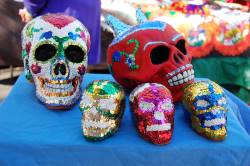 “The Day of the Dead
Alive and Well in Middle Tennessee” (Patricia
Gaitley, 2018, 27:40 minutes). Gaitley ‘s talk
considers how a traditional Mexican calendar celebration—“The
Day of the Dead” —is being commemorated and adapted in
Tennessee. Mexican communities and families uphold
traditions of Dio de los Muertos to honor and sustain the memory
of the deceased. As the state’s Mexican population has
grown, The Day of the Dead has taken on other significance and
purposes in celebrations beyond Mexican communities.
Gaitley recognizes this process in reporting on the Day of the
Dead celebration at Nashville’s Cheekwood Museum of Art,
where artistic aspects of the tradition are highlighted, Mexican
artists are showcased, and community members
invited. As the event embodies support for Mexican
Nashvillians, the inclusiveness of its programming (also
welcoming involvement by other Central and South American
communities who do not celebrate Day of the Dead) is also
tending toward a pan-Hispanic event. Gaitley’s
interviews with vendors and participants, both Hispanic and
non-Hispanic, provide insights into a celebration in transition.
“The Day of the Dead
Alive and Well in Middle Tennessee” (Patricia
Gaitley, 2018, 27:40 minutes). Gaitley ‘s talk
considers how a traditional Mexican calendar celebration—“The
Day of the Dead” —is being commemorated and adapted in
Tennessee. Mexican communities and families uphold
traditions of Dio de los Muertos to honor and sustain the memory
of the deceased. As the state’s Mexican population has
grown, The Day of the Dead has taken on other significance and
purposes in celebrations beyond Mexican communities.
Gaitley recognizes this process in reporting on the Day of the
Dead celebration at Nashville’s Cheekwood Museum of Art,
where artistic aspects of the tradition are highlighted, Mexican
artists are showcased, and community members
invited. As the event embodies support for Mexican
Nashvillians, the inclusiveness of its programming (also
welcoming involvement by other Central and South American
communities who do not celebrate Day of the Dead) is also
tending toward a pan-Hispanic event. Gaitley’s
interviews with vendors and participants, both Hispanic and
non-Hispanic, provide insights into a celebration in transition.
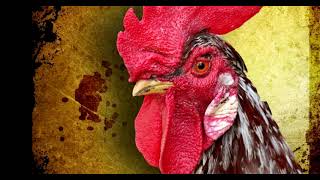 “Cockfighting in East
Tennessee and Western North Carolina: An Interpretation
from Oral History.” (Charles Gunter,
audio only from 1978, 28:33 minutes). A
geography professor at ETSU, Gunter drew upon student interviews
with two cockfighters to report on this controversial form
of gaming long practiced in the rural South. His talk
identifies numerous aspects of folk lingo and customs shared among
cockfighters, and it focuses on four topics: the raising and
conditioning of game fowl; the mechanics of fights or
“derbies”; legal issues in respect to
cockfighting; and the views of cockfighters regarding their
involvement in a sport prohibited by law. Soon after his
presentation, a published version of the paper appeared in the
Tennessee Folklore Society Bulletin, and it was later reprinted in
the 2009 TFS anthology A Tennessee Folklore Sampler. Images
accompanying this audio track were not part of his original
presentation, and they were compiled mostly from later sources.
“Cockfighting in East
Tennessee and Western North Carolina: An Interpretation
from Oral History.” (Charles Gunter,
audio only from 1978, 28:33 minutes). A
geography professor at ETSU, Gunter drew upon student interviews
with two cockfighters to report on this controversial form
of gaming long practiced in the rural South. His talk
identifies numerous aspects of folk lingo and customs shared among
cockfighters, and it focuses on four topics: the raising and
conditioning of game fowl; the mechanics of fights or
“derbies”; legal issues in respect to
cockfighting; and the views of cockfighters regarding their
involvement in a sport prohibited by law. Soon after his
presentation, a published version of the paper appeared in the
Tennessee Folklore Society Bulletin, and it was later reprinted in
the 2009 TFS anthology A Tennessee Folklore Sampler. Images
accompanying this audio track were not part of his original
presentation, and they were compiled mostly from later sources.
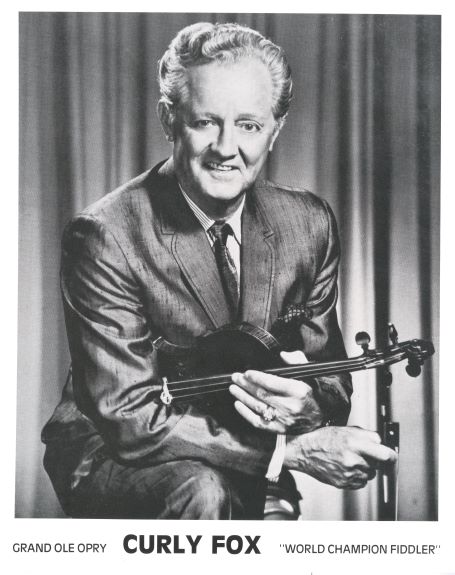
“Curly Fox:
Fiddler” (audio only from 1981, 39:40
minutes). Influential East Tennessee fiddler Curly
Fox (1910-1995) began his career in the late 1920s playing
with a medicine show and regional stringbands. In 1937
he partnered with his wife Texas Ruby, and they became widely
known for several decades through stints on the Grand Ole Opry
and radio and television broadcasting in Cincinnatti and
Houston. Ruby died in 1963, and in the 1970s Curly
retired to his hometown of Graysville, making occasional
appearances accompanied by Tom Morgan and his family
band. In 1981 he played with the Morgans at the annual
Tennessee Folklore Society meeting in Cookeville.
Recordings of that performance capture the polished fiddling
and showmanship for which he was
known.
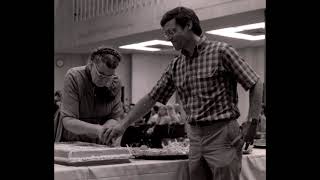 “Linnie Johnson:
Unaccompanied Ballad Singer” (audio only from
1981 & 1984, 24:03 minutes). Linnie Johnson
(1910-1997) of Johnson Chapel , DeKalb County, was among
Tennessee’s few surviving unaccompanied ballad singers when she
was documented for the Tennessee State Parks Folklife
Project in 1981 by Betsy Peterson, who is now director of
the American Folklife Center at the Library of
Congress. Mrs. Johnson’s tradition was very much a
domestic one. She learned most of her tunes from
her father’s singing in the family household, and she in turn sang
mostly at home from youth through adulthood.
Like many singers of local and family songs, she often referred to
a hand-written ballad book full of song lyrics, which preserved
remnants of British balladry, later sentimental love songs, and
historic songs native to her area. One of the jewels of her
repertory, “The Raftsman’s Song,” was included in Historical
Ballads of the Tennessee Valley ( TFS-105) a documentary LP
released by the society in 1982. The following recordings
come from her first public performance at the 1981 TFS meeting,
and from her singing at the 1984 meeting , where with Bob
Fulcher’s assistance, she cut the cake in celebration of the
50th anniversary of the Tennessee Folklore Society.
“Linnie Johnson:
Unaccompanied Ballad Singer” (audio only from
1981 & 1984, 24:03 minutes). Linnie Johnson
(1910-1997) of Johnson Chapel , DeKalb County, was among
Tennessee’s few surviving unaccompanied ballad singers when she
was documented for the Tennessee State Parks Folklife
Project in 1981 by Betsy Peterson, who is now director of
the American Folklife Center at the Library of
Congress. Mrs. Johnson’s tradition was very much a
domestic one. She learned most of her tunes from
her father’s singing in the family household, and she in turn sang
mostly at home from youth through adulthood.
Like many singers of local and family songs, she often referred to
a hand-written ballad book full of song lyrics, which preserved
remnants of British balladry, later sentimental love songs, and
historic songs native to her area. One of the jewels of her
repertory, “The Raftsman’s Song,” was included in Historical
Ballads of the Tennessee Valley ( TFS-105) a documentary LP
released by the society in 1982. The following recordings
come from her first public performance at the 1981 TFS meeting,
and from her singing at the 1984 meeting , where with Bob
Fulcher’s assistance, she cut the cake in celebration of the
50th anniversary of the Tennessee Folklore Society.
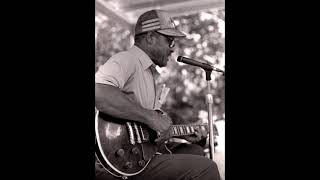 “Bud Garrett:
Bluesman” (audio only from 1981, 22:30
minutes). Patriarch of the rural African American community
in Free Hill, Tennessee, near Celina, Bud Garrett (1916-1987) was
a widely-known character among players of the unique
“rolley-hole” marble game local to surrounding counties along the
Tennessee-Kentucky line. His handmade flint marbles were
prized by shooters throughout the region, and the marble yard that
Bud maintained on Free Hill was an active social scene among the
game’s many enthusiasts—black and white alike. Bud also grew
up around music and became a skilled guitarist and singer, exposed
to a wide variety of musical influences. As a
bluesman, he followed the stylings of postwar urban blues, and was
drawn to wide-ranging novelty songs that suited his outgoing
manner, some of which he wrote himself. He had aspirations
to record and some contacts in Nashville’s R&B recording
scene, but he only released a single 45 on the Excello label.
“Bud Garrett:
Bluesman” (audio only from 1981, 22:30
minutes). Patriarch of the rural African American community
in Free Hill, Tennessee, near Celina, Bud Garrett (1916-1987) was
a widely-known character among players of the unique
“rolley-hole” marble game local to surrounding counties along the
Tennessee-Kentucky line. His handmade flint marbles were
prized by shooters throughout the region, and the marble yard that
Bud maintained on Free Hill was an active social scene among the
game’s many enthusiasts—black and white alike. Bud also grew
up around music and became a skilled guitarist and singer, exposed
to a wide variety of musical influences. As a
bluesman, he followed the stylings of postwar urban blues, and was
drawn to wide-ranging novelty songs that suited his outgoing
manner, some of which he wrote himself. He had aspirations
to record and some contacts in Nashville’s R&B recording
scene, but he only released a single 45 on the Excello label.
Betsy Peterson’s 1981 work with the Tennessee State Parks Folklife
Project led to Bud’s frequent appearances as both as a
marble-maker and a performer at regional events and at the 1986
Smithsonian Festival of American Folklife, for which his engaging
personality made him especially well-suited. Bud was also
featured on “Free Hill A Sound Portrait Of A Rural Afro-American
Community” (TFS-107) a documentary LP released by the
society in 1985, and he was later the subject of Peterson’s
doctoral dissertation. The following recordings come from
Bud’s performance at the TFS 1981 annual meeting .
 “Jamboree Time:
Remembering Radio in East Tennessee” (Bradley
Hanson, 2015, 30:46 minutes). This documentary video
is the result of Hanson’s lengthy research , initiated in
fieldwork for the Tennessee State Parks Folklife Project and
culminating in his doctoral dissertation, on one
community’s musical and broadcasting history. The
Tennessee Jamboree was a weekly musical “barndance” event in
LaFollette, Tennessee, broadcast on local radio station WLAF
from 1953 to 1978. Drawing on Hanson’s interviews and rare
surviving film clips, the video details the story of this
small-town cultural scene, the musicians and businesses
who helped it succeed, and its contributions to the life of the
community.
“Jamboree Time:
Remembering Radio in East Tennessee” (Bradley
Hanson, 2015, 30:46 minutes). This documentary video
is the result of Hanson’s lengthy research , initiated in
fieldwork for the Tennessee State Parks Folklife Project and
culminating in his doctoral dissertation, on one
community’s musical and broadcasting history. The
Tennessee Jamboree was a weekly musical “barndance” event in
LaFollette, Tennessee, broadcast on local radio station WLAF
from 1953 to 1978. Drawing on Hanson’s interviews and rare
surviving film clips, the video details the story of this
small-town cultural scene, the musicians and businesses
who helped it succeed, and its contributions to the life of the
community.  “
“
 “Cockfighting in East
Tennessee and Western North Carolina: An Interpretation
from Oral History.” (Charles Gunter,
audio only from 1978, 28:33 minutes). A
geography professor at ETSU, Gunter drew upon student interviews
with two cockfighters to report on this controversial form
of gaming long practiced in the rural South. His talk
identifies numerous aspects of folk lingo and customs shared among
cockfighters, and it focuses on four topics: the raising and
conditioning of game fowl; the mechanics of fights or
“derbies”; legal issues in respect to
cockfighting; and the views of cockfighters regarding their
involvement in a sport prohibited by law. Soon after his
presentation, a published version of the paper appeared in the
Tennessee Folklore Society Bulletin, and it was later reprinted in
the 2009 TFS anthology A Tennessee Folklore Sampler. Images
accompanying this audio track were not part of his original
presentation, and they were compiled mostly from later sources.
“Cockfighting in East
Tennessee and Western North Carolina: An Interpretation
from Oral History.” (Charles Gunter,
audio only from 1978, 28:33 minutes). A
geography professor at ETSU, Gunter drew upon student interviews
with two cockfighters to report on this controversial form
of gaming long practiced in the rural South. His talk
identifies numerous aspects of folk lingo and customs shared among
cockfighters, and it focuses on four topics: the raising and
conditioning of game fowl; the mechanics of fights or
“derbies”; legal issues in respect to
cockfighting; and the views of cockfighters regarding their
involvement in a sport prohibited by law. Soon after his
presentation, a published version of the paper appeared in the
Tennessee Folklore Society Bulletin, and it was later reprinted in
the 2009 TFS anthology A Tennessee Folklore Sampler. Images
accompanying this audio track were not part of his original
presentation, and they were compiled mostly from later sources.
 “Linnie Johnson:
Unaccompanied Ballad Singer” (audio only from
1981 & 1984, 24:03 minutes). Linnie Johnson
(1910-1997) of Johnson Chapel , DeKalb County, was among
Tennessee’s few surviving unaccompanied ballad singers when she
was documented for the Tennessee State Parks Folklife
Project in 1981 by Betsy Peterson, who is now director of
the American Folklife Center at the Library of
Congress. Mrs. Johnson’s tradition was very much a
domestic one. She learned most of her tunes from
her father’s singing in the family household, and she in turn sang
mostly at home from youth through adulthood.
Like many singers of local and family songs, she often referred to
a hand-written ballad book full of song lyrics, which preserved
remnants of British balladry, later sentimental love songs, and
historic songs native to her area. One of the jewels of her
repertory, “The Raftsman’s Song,” was included in Historical
Ballads of the Tennessee Valley ( TFS-105) a documentary LP
released by the society in 1982. The following recordings
come from her first public performance at the 1981 TFS meeting,
and from her singing at the 1984 meeting , where with Bob
Fulcher’s assistance, she cut the cake in celebration of the
50th anniversary of the Tennessee Folklore Society.
“Linnie Johnson:
Unaccompanied Ballad Singer” (audio only from
1981 & 1984, 24:03 minutes). Linnie Johnson
(1910-1997) of Johnson Chapel , DeKalb County, was among
Tennessee’s few surviving unaccompanied ballad singers when she
was documented for the Tennessee State Parks Folklife
Project in 1981 by Betsy Peterson, who is now director of
the American Folklife Center at the Library of
Congress. Mrs. Johnson’s tradition was very much a
domestic one. She learned most of her tunes from
her father’s singing in the family household, and she in turn sang
mostly at home from youth through adulthood.
Like many singers of local and family songs, she often referred to
a hand-written ballad book full of song lyrics, which preserved
remnants of British balladry, later sentimental love songs, and
historic songs native to her area. One of the jewels of her
repertory, “The Raftsman’s Song,” was included in Historical
Ballads of the Tennessee Valley ( TFS-105) a documentary LP
released by the society in 1982. The following recordings
come from her first public performance at the 1981 TFS meeting,
and from her singing at the 1984 meeting , where with Bob
Fulcher’s assistance, she cut the cake in celebration of the
50th anniversary of the Tennessee Folklore Society. “Bud Garrett:
Bluesman” (audio only from 1981, 22:30
minutes). Patriarch of the rural African American community
in Free Hill, Tennessee, near Celina, Bud Garrett (1916-1987) was
a widely-known character among players of the unique
“rolley-hole” marble game local to surrounding counties along the
Tennessee-Kentucky line. His handmade flint marbles were
prized by shooters throughout the region, and the marble yard that
Bud maintained on Free Hill was an active social scene among the
game’s many enthusiasts—black and white alike. Bud also grew
up around music and became a skilled guitarist and singer, exposed
to a wide variety of musical influences. As a
bluesman, he followed the stylings of postwar urban blues, and was
drawn to wide-ranging novelty songs that suited his outgoing
manner, some of which he wrote himself. He had aspirations
to record and some contacts in Nashville’s R&B recording
scene, but he only released a single 45 on the Excello label.
“Bud Garrett:
Bluesman” (audio only from 1981, 22:30
minutes). Patriarch of the rural African American community
in Free Hill, Tennessee, near Celina, Bud Garrett (1916-1987) was
a widely-known character among players of the unique
“rolley-hole” marble game local to surrounding counties along the
Tennessee-Kentucky line. His handmade flint marbles were
prized by shooters throughout the region, and the marble yard that
Bud maintained on Free Hill was an active social scene among the
game’s many enthusiasts—black and white alike. Bud also grew
up around music and became a skilled guitarist and singer, exposed
to a wide variety of musical influences. As a
bluesman, he followed the stylings of postwar urban blues, and was
drawn to wide-ranging novelty songs that suited his outgoing
manner, some of which he wrote himself. He had aspirations
to record and some contacts in Nashville’s R&B recording
scene, but he only released a single 45 on the Excello label.